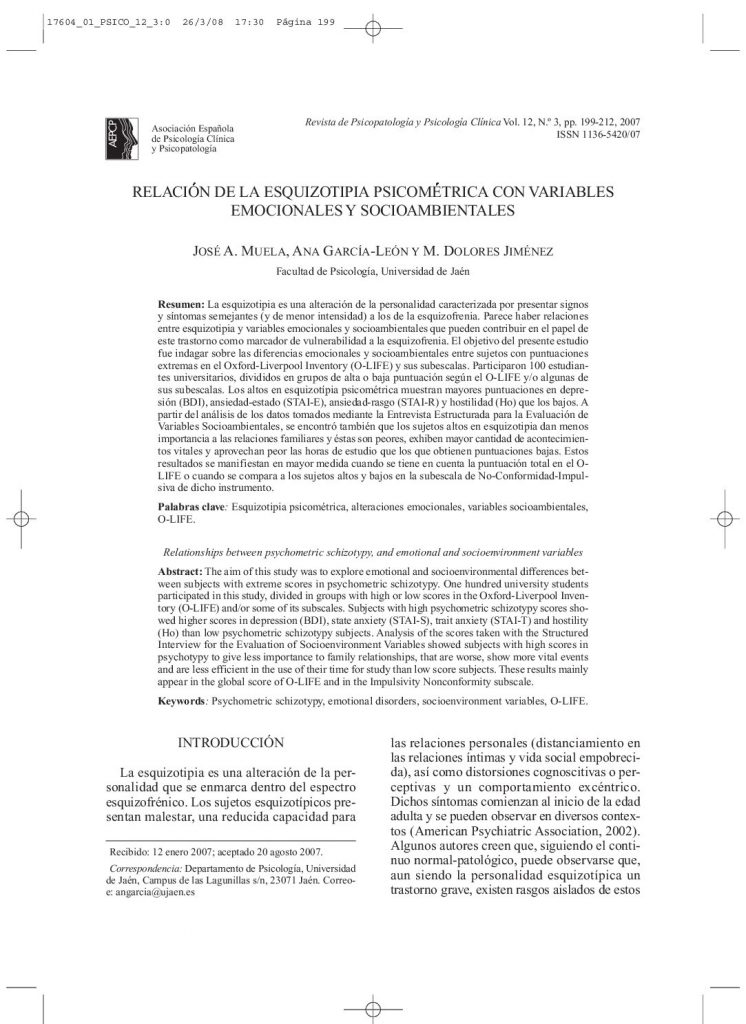Relación de la esquizotipia psicométrica con variables emocionales y socioambientales.

- Subtipos de ansiedad social en población adulta e infanto-juvenil: Distinción cuantitativa versus cualitativa.
- Propiedades psicométricas de la Escala de Miedo a la Evaluación Negativa versión breve (BFNE) en muestra clínica.
- Rendimiento cognitivo y síntomas afectivos en la fase aguda y tres meses después de un ictus isquémico.
- Cuestionario de afrontamiento del estrés (CAE): Validación en una muestra mexicana.
- Relación de la esquizotipia psicométrica con variables emocionales y socioambientales.
- Información sobre criterios de calidad de la Revista de Psicopatología y Psicología Clínica.
The aim of this study was to explore emotional and socioenvironmental differences between subjects with extreme scores in psychometric schizotypy. One hundred university students participated in this study, divided in groups with high or low scores in the Oxford-Liverpool Inventory (O-LIFE) and/or some of its subscales. Subjects with high psychometric schizotypy scores showed higher scores in depression (BDI), state anxiety (STAI-S), trait anxiety (STAI-T) and hostility (Ho) than low psychomet-ric schizotypy subjects. Analysis of the scores taken with the Structured Interview for the Evaluation of Socioenvironment Variables showed subjects with high scores in psychotypy to give less importance to family relationships, that are worse, show more vital events and are less efficient in the use of their time for study than low score subjects. These results mainly appear in the global score of O-LIFE and in the Impulsivity Nonconformity subscale.
La esquizotipia es una alteración de la personalidad caracterizada por presentar signos y síntomas semejantes (y de menor intensidad) a los de la esquizofrenia. Parece haber relaciones entre esquizo-tipia y variables emocionales y socioambientales que pueden contribuir en el papel de este trastorno como marcador de vulnerabilidad a la esquizofrenia. El objetivo del presente estudio fue indagar so-bre las diferencias emocionales y socioambientales entre sujetos con puntuaciones extremas en el Oxford-Liverpool Inventory (O-LIFE) y sus subescalas. Participaron 100 estudiantes universitarios, divididos en grupos de alta o baja puntuación según el O-LIFE y/o algunas de sus subescalas. Los altos en esquizotípia psicométrica muestran mayores puntuaciones en depresión (BDI), ansiedad-estado (STAI-E), ansiedad-rasgo (STAI-R) y hostilidad (Ho) que los bajos. A partir del análisis de los datos tomados mediante la Entrevista Estructurada para la Evaluación de Variables Socioambienta-les, se encontró también que los sujetos altos en esquizotipia dan menos importancia a las relaciones familiares y éstas son peores, exhiben mayor cantidad de acontecimientos vitales y aprovechan peor las horas de estudio que los que obtienen puntuaciones bajas. Estos resultados se manifiestan en mayor medida cuando se tiene en cuenta la puntuación total en el O-LIFE o cuando se compara a los sujetos altos y bajos en la subescala de No-Conformidad-Impulsiva de dicho instrumento.



